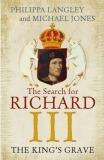The King’s Grave
Book Review: The King’s Grave
Philippa Langley, Michael Jones, The King’s Grave. St. Martin’s Press, 2013
All of us in the Richard III Society and many others followed the discovery of what was later confirmed to be Richard III’s remains under the car park in Leicester with fascination and awe. In several homes the champagne corks popped, when it was announced on 4 February 2013 that these remains were indeed those of Richard III.
The King’s Grave is written by Philippa Langley and Michael Jones. It would be safe to say that without Philippa’s drive and determination the Greyfriars Dig would never have taken place. Michael Jones is a well-known historian of the period. Here the authors are telling two different but related tales in alternating chapters in one book about “a search for Richard’s remains – and also, accompanying it, the search for his real historical reputation.” [Preface]
Philippa recounts the story of the lead-up to the dig, the time of the dig itself and its fantastic result. While it gives a good day to day account of the dig, it is also a very personal story and the reader experiences with her all the frustrations, hiccups and anxieties she felt along the way, thus making it personal for the reader as well. However, it has to be said that this very emotional style, the constant use of the word “I” and the frequent reminders of the strange sensation she first experienced in the car park in May 2004, might come across as if it was all about Philippa, though she does acknowledge John Ashdown-Hill and Annette Carson and others.
Michael on the other hand provides the historical background to Richard’s life – and death – in a sympathetic, but unsentimental way. His aim is “Not to condemn him, nor to sanitize his actions, but to place him firmly back in the context of his times” [Preface] and he succeeded in doing so. He emphasizes Richard’s keen sense of justice and religiousness.
The conclusion is that
“Richard III wasn’t a saint. He was a man, who played the hand he was dealt loyally and, as far as he could within the limitations of his time, humanely. Above all, whether on and off the battlefield, he never failed to display courage.” [Chapter 11: The Man Behind the Myth]
The mystery of what happened to Edward IV’s sons, though not related to the archaeological search for Richard, but very much part of “the search for his real historical reputation”, is dealt with in an Appendix. Here the two authors agree to disagree. Philippa explaining convincingly why Richard should be innocent and Michael explaining equally convincingly why he probably had to do it.
A second appendix to The King’s Grave is about the psychological analysis of Richard III by Prof Mark Lansdale and Julian Booth, a more extensive version of this was included in the March 2013 Ricardian Bulletin.
The King’s Grave is illuminated by many examples, some of them well-known to a Ricardian, some maybe less so. Thomas Barowe, and his generous gift to Cambridge University as a memorial of Richard III is mentioned. The book also introduces the reader to Jane Sacheverell and the way she changed the law.
I found it interesting to find out that, while Henry had Richard’s body displayed in Leicester, he himself moved on to Coventry to celebrate his victory, before returning to Leicester and then continuing on to London.
The King’s Grave is a book that will resonate with any Ricardian who lived through this exciting period, but will also be of interest to readers, who might not have followed the events with so much enthusiasm while they unfolded.
You can watch a short interview with the author’s of The King’s Grave on YouTube.
This is a review of an advance ebook copy supplied by the publishers through NetGalley.com. Quotes are therefore referenced by chapters rather than page numbers.
Tags: Books, Leicester, Leicester Greyfriars Dig, Richard III


Leave a reply